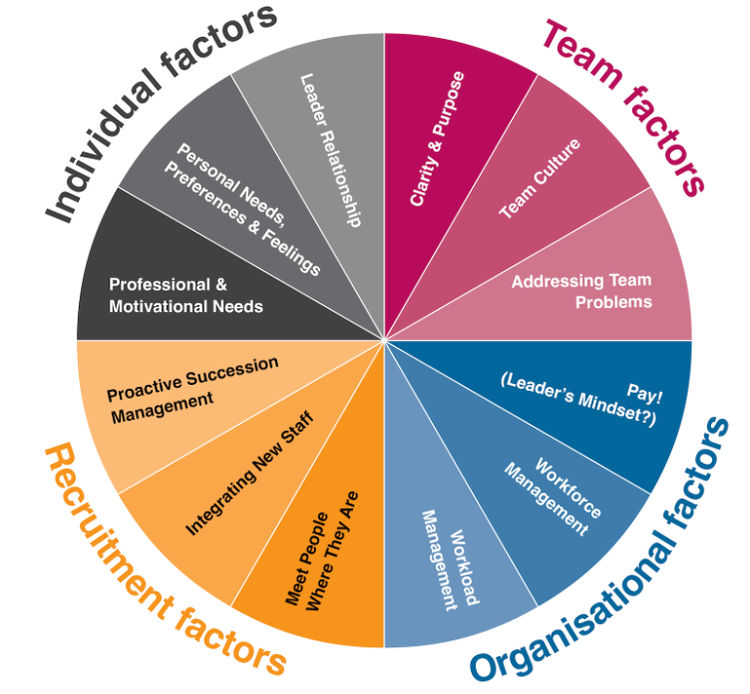
Author: Belinda Bryant
First Published: 2022
An extraordinary set of economic, social and immigration factors seems to have landed us with a perfect storm of retention and recruitment challenges. This means leaders and organisations really need to get proactive about managing their capacity.
Choosing your Approach to the Retention Challenge
There are many things a leader might give some extra time and attention to to help address retention. We have developed a Wheel of Retention, to help guide reflection about which will deliver the most impact for their effort.

Click through for a video giving a deeper explanation of this tool and other supporting materials.
‘Stay Conversations’ – One approach to address the “Individual Factors”
One valuable approach to the “Individual Factors” referenced above is often referred to as ‘stay conversations’. This name is a little misleading, because, when done well, having these conversations are not just a response to specific retention concerns – but also a valuable engagement tool and information gathering strategy.
A few things to think about in planning ‘stay conversations’
1. Talk to everyone or just ‘high risk’ staff?
The obvious point is there are risks with singling people out – so for the most part I would suggest that having these conversations has a whole lot of value and it makes sense to be consistent with everyone. I would suggest the exception is where there is someone whose flight presents such a concern that you are going to be able to accomodate their requests to a much greater extent than other team members. In this case, the sense of unfairness might be even greater if you ask everyone what they would value and then grant substantially more requests for one team member – so a discreet conversation with that indivdual is probably the best approach!
2. Should you use the term “Stay Conversation”
As we have said, the label itself is misleading. However there are some benefits in being transparent that you are going to catch up with everyone and work through a few questions to check in about what is going on for them. These conversations are most useful if people are willing and able to reflect deeply on what matters to them, what is working for them and what could be improved – and then to share this information clearly and honestly. Some people find this much easier if they have had the opportunity to think about it ahead of time.
3. Duration and Location
Some suggest 15 minutes – sounds a little short to us – but it’s probably a style thing and some managers could achieve a very effective check in in 15 minutes. Booking an hour sets quite a different tone – an opportunity to go deep and potentially do some meaningful coaching. We met one fantastic leader who believes this kind of korero should continue until everyone is done. She manages this by booking these kind of conversations for an hour at 1pm but makes sure her diary is clear for the rest of the day and takes as long as is needed. For the most part, I suggest 30 minutes hits a good middle ground.
For location, there can be real merit in heading out of the office – and even grabbing a couple of coffees and going for a walk. Communicating side by side – and while walking – can make long thinking pauses feel much more comfortable and make uncomfortable truths easier to share.
4. Psychological Safety
I suspect the need for this is well understood in this audience and I won’t go into it in depth. So the only point I will make here is that in some instances there is value in having someone other than the leader conduct stay conversations with team members. The reality is if the leader is the problem they are unlikely to get the answers that they need to hear for this to be of use. In those cases the leader’s leader or an HR professional might offer a better alternative. If so, this raises some risks of psychological safety of its own for the team manager and potentially manager – which need to be considered.
What to talk about
The essence of these conversations is uncovering risks – what issues or irritants are impacting people – and opportunities – what changes could support their work and happiness. These might be explored under the headings:
- Engagement
- Improvement
- Development
This document break’s down these ideas a little more and offers some questions suggestions. Watch excerpt from July Webinar on Stay Conversations.
Conclusion
Like most things – there is no silver bullet. But there is an opportunity for managers and HR professionals to bring some clear strategic thinking to how they respond to the retention challenges they are facing – and make some meaningful impact on their prospect of keeping their team in tact and functioning as we move through this particularly challenging face.
